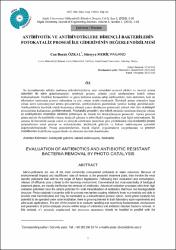| dc.contributor.author | Özkal, Can Burak | |
| dc.contributor.author | Meriç, Süreyya | |
| dc.date.accessioned | 2022-05-11T14:17:08Z | |
| dc.date.available | 2022-05-11T14:17:08Z | |
| dc.date.issued | 2016 | |
| dc.identifier.issn | 2147-012X | |
| dc.identifier.uri | https://app.trdizin.gov.tr/makale/TVRnNU5UY3dNQT09 | |
| dc.identifier.uri | https://hdl.handle.net/20.500.11776/6204 | |
| dc.description.abstract | Su kaynaklarında sıklıkla rastlanan mikrokirleticilerin, alıcı ortamdaki çevresel etkileri ve mevcut arıtma sistemleri ile etkin giderilememeleri sebebiyle gelecek yıllarda yasal sınırlamaların hedefi olması beklenmektedir. Özellikle farmasötikler ve geniş kullanım alanına sahip antibiyotikler, hem üretimleri, hem de tüketimleri sonrasında çevreye salınmakta ve alıcı ortamı tehdit etmektedir. Biyolojik arıtma sistemleri başta olmak üzere konvansiyonel arıtma proseslerinin, antibiyotiklerin gideriminde yetersiz kaldığı görülmektedir. Antibiyotiklerin biyolojik olarak bozunmaya dirençli yapısı oksidasyon potansiyeli yüksek olan ileri oksidasyon proseslerinin kullanımını gerektirmektedir. Fotokataliz prosesleri, eko-toksik etkisinin minimum düzeyde olması ve antibiyotikleri mineralize edebilme potansiyeli ile önemli bir detoksifikasyon prosesidir. Ayrıca prosesin güneş enerjisi ile işletilebilir olması, deneysel çalışma ve pilot ölçekli uygulamalara olan ilgiyi arttırmaktadır. Bu çalışma ile literatürde askıda sistem ve yüzeyde sabitlenme prensibine göre yürütülmekte olan fotokataliz prosesi çalışmalarının temel prensip ve mekanizmaları, antibiyotik giderimi ve bakteri inaktivasyonu açısından değerlendirilmektedir. Proses parametrelerinin, büyük ölçekli uygulamaların yaygınlaşması ve prosesin modellenmesi hedeflerine uygun olarak ele alınması üzerinde durulmuştur. | en_US |
| dc.description.abstract | Micro-pollutants are one of the most commonly encountered pollutants in water resources. Because of environmental impacts and insufficient rates of removal at the prevalent treatment plant, they involve the most specific pollutants that will be the target of future legislations. Following their production and consumption, releases of effluents pose a threat to the receiving environment. Conventional but most essentially of biological treatment plants, are mostly ineffective for removal of antibiotics. Advanced oxidation processes with their high oxidation potentials have the utmost potential for total mineralization of antibiotics that have non-biodegradable structure. Photo-catalysis is superior with its process mechanism causing relatively lower eco-toxicity and able to provide total mineralization and may be nominated as a detoxification process option. Since photo-catalysis has potential to be operated under solar irradiation, there is growing interest in both laboratory scale experiments and pilot scale applications. The aim of this review is to evaluate handling and examining fundamentals, mechanisms and parameters of photo-catalysis process within scope of antibiotics and antibiotic resistant bacteria removal. In this concept, it s precisely emphasized that processes parameters should be handled in parallel with the underlying goals of making larger scale applications become widespread and modelling the photocatalytic process. | en_US |
| dc.language.iso | tur | en_US |
| dc.rights | info:eu-repo/semantics/openAccess | en_US |
| dc.title | Antibiyotik ve Antibiyotiklere Dirençli Bakterilerin Fotokataliz Prosesi İle Gideriminin Değerlendirilmesi | en_US |
| dc.title.alternative | Evaluation Of Antibiotics and Antibiotic Resistant Bacteria Removal By Photo-Catalysis | en_US |
| dc.type | article | en_US |
| dc.relation.ispartof | Niğde Üniversitesi Mühendislik Bilimleri Dergisi | en_US |
| dc.department | Fakülteler, Çorlu Mühendislik Fakültesi, Çevre Mühendisliği Bölümü | en_US |
| dc.identifier.volume | 5 | en_US |
| dc.identifier.issue | 1 | en_US |
| dc.identifier.startpage | 1 | en_US |
| dc.identifier.endpage | 18 | en_US |
| dc.institutionauthor | Özkal, Can Burak | |
| dc.institutionauthor | Meriç, Süreyya | |
| dc.identifier.trdizinid | TVRnNU5UY3dNQT09 | en_US |



















